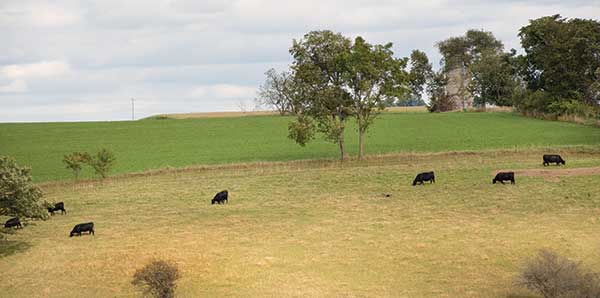The author is a freelance writer from Bozeman, Mont., and has her own communications business, Cowpunch Creative.

When it comes to grazing better, Tim Steffens says what he absolutely does not want to talk about are grazing systems.
Steffens, who serves as an AgriLife extension specialist in rangeland resource management with West Texas A&M University, says, “Many named grazing systems have been tried and some actually worked, but oftentimes systems fail because they are not adaptive enough.”
Instead, Steffens suggests graziers turn to the concrete facts science knows about grazing to help devise successful and adaptive grazing strategies. He detailed these strategies at the Annual Society for Range Management Meeting in Corpus Christi, Texas. Steffens listed 10 key concepts, many known for some time.
Concept No. 1 - Severe defoliation, also known as overgrazing, takes off photosynthetic material and arrests root growth, making it difficult for plants to compete with neighboring plants. This is one of the main reasons the “take half, leave half” rule came into being, noted Steffens.
Concept No. 2 - Forage demand, also referred to as stocking rate, determines the average rate of defoliation. Where the problem lies, however, is cattle do not know they are supposed to follow the “take half, leave half” rule.
Concept No. 3 - Timing can be influential to defoliation of plants.
“If we defoliate a plant during the dormant season or before the plant’s growing point elevates, it’s not such a big deal as long as it doesn’t happen again,” said Steffens. “The worst result for a single grazing event is when we take off the growing point.”
Concept No. 4 - Recovery is required after defoliation.
“Once severe defoliation occurs, plants need a chance to recover,” said Steffens. “It (the plant) has to put out another set of leaves and store enough energy to take care of itself.”
The length of the recovery period depends upon how much plants were defoliated, what the growing conditions are, and when in terms of plant growth the plant was defoliated.
Concept No. 5 - Germination and establishment can occur quickly in environments where moisture is readily available. A lot of times, however, Steffens says that because periods of growth are often short and erratic, the time it takes for a plant to establish may be longer than expected. If plants are defoliated more than once before they are fully mature, mortality will increase significantly. When establishing new stands, more recovery may be needed.
Concept No. 6 - At the landscape scale, grazing animals do not graze over a whole area evenly. Steffens explained that factors such as topography, weather, location, season, proximity to water and species composition can all impact how much animals graze one area versus another. When animals use preferred areas repeatedly, overgrazing occurs; when observed on a small scale, this can be an indicator of larger pasture degradation to come.
Concept No. 7 - To make changes in defoliation or grazing intensity, graziers must change how animals interact with the plants and the landscape.
“There’s nothing magical about having lots of pastures for a herd of animals and moving them around,” said Steffens.
Steffens makes it clear that in these situations, continuous grazing and overgrazing can still occur. What matters instead, he expounds, is giving plants adequate recovery periods; getting livestock to graze more evenly via higher stocking densities and more frequent moves; and making an effort to change up the time of year and season of use for pastures over their useful life.
Concept No. 8 – The animal’s ability to meet nutrient demands is a function of quality and quantity of forage available. Cattle will graze both the most palatable and lesser palatable plants if given the opportunity. However, if only lower-quality forage is available, animal performance will decline.
Concept No. 9 - On a fixed land base with a set number of animals, if the number of paddocks is increased and cattle are grazed at a higher density, it does not necessarily mean the livestock will graze paddocks more intensely.
“It’s a rate and time issue,” said Steffens. “I can have animals at a high density and the forage disappears quicker. But if I have a much shorter graze period based on the smaller paddock size, I will graze it to a much lighter intensity.”
Concept No. 10 - When cattle use a greater proportion of the pasture or graze a greater variety of plants, stocking rate can be sustainably increased if pastures receive sufficient recovery periods between grazing.
Steffens closed the talk by noting that grazing systems, much like fixed policies, do not work well. In their place, adaptive grazing strategies based on the listed 10 concepts, with a focus on ecological health, offer graziers more flexibility and control.
Therefore, Steffens said, “Don’t apply someone else’s grazing system. Figure out what your farm has and put together a plan based on that.”
This article appeared in the March 2016 issue of Hay & Forage Grower on page 26.
Not a subscriber? Click to get the print magazine.

